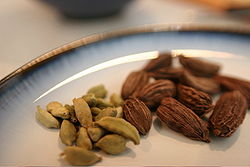 |
|
|
|
|
| Cuisines | Herbal | Spice | Curry | Yeast | Recipe | ||||||
|
Cardamom Cardamom (or cardamon) refers to several plants of the similar genera Elettaria and Amomum in the ginger family Zingiberaceae. Both genera are native to India, Nepal and Bhutan; they are recognised by their small seed pods, triangular in cross-section and spindle-shaped, with a thin, papery, outer shell and small black seeds. Today, Guatemala is the biggest producer and exporter of Cardamom in the world, followed by India. Some other countries such as Sri Lanka have also begun to cultivate it. Elettaria pods are light green while Amomum pods are larger and dark brown. UsesBoth forms of cardamom are used as flavorings in both food and drink, as cooking spices and as a medicine. E. cardamomum (the usual type of cardamom) is used as a spice, a masticatory, and in medicine; it is also smoked sometimes. Food and drink Cardamom has a strong, unique taste, with an intensely aromatic, resinous fragrance. Black cardamom has a distinctly more smokey, though not bitter, aroma, with a coolness some consider similar to mint. Green cardamom is one of the most expensive spices by weight, but little is needed to impart the flavor. It is best stored in pod form because once the seeds are exposed or ground, they quickly lose their flavor. However, high-quality ground cardamom is often more readily (and cheaply) available and is an acceptable substitute. For recipes requiring whole cardamom pods, a generally accepted equivalent is 10 pods equals 1?teaspoons of ground cardamom. It is a common ingredient in Indian cooking and is often used in baking in Nordic countries, such as in the Finnish sweet bread pulla or in the Scandinavian bread Julekake. In the Middle East, green cardamom powder is used as a spice for sweet dishes, as well as traditional flavouring in coffee and tea. Cardamom pods are ground together with coffee beans to produce a powdered mixture of the two, which is boiled with water to make coffee. Cardamom is used to some extent in savoury dishes. In some Middle Eastern countries, coffee and cardamom are often ground in a wooden mortar, a mihbaj, and cooked together in a skillet, a mehmas, over wood or gas, to produce mixtures as much as 40% cardamom. In South Asia, green cardamom is often used in traditional Indian sweets and in masala chai (spiced tea). Black cardamom is sometimes used in garam masala for curries. It is occasionally used as a garnish in basmati rice and other dishes. It is often referred to as fat cardamom due to its size. Individual seeds are sometimes chewed and used in much the same way as chewing gum; it is even used by Wrigley's ('Eclipse Breeze Exotic Mint') where it states "with cardamom to neutralize the toughest breath odors." It has been known to be used for gin making. Traditional medicineGreen cardamom is broadly used in South Asia to treat infections in teeth and gums, to prevent and treat throat troubles, congestion of the lungs and pulmonary tuberculosis, inflammation of eyelids and also digestive disorders. It also is used to break up kidney stones and gall stones, and was reportedly used as an antidote for both snake and scorpion venom. Amomum is used as a spice and as an ingredient in traditional medicine in systems of the traditional Chinese medicine in China, in Ayurveda in India, Pakistan, Japan, Korea and Vietnam. Species in the genus Amomum are also used in traditional Indian medicine. Among other species, varieties and cultivars, Amomum villosum cultivated in China, Laos and Vietnam is used in traditional Chinese medicine to treat stomach issues, constipation, dysentery, and other digestion problems. Tsaoko cardamom Amomum tsao-ko is cultivated in Yunnan, China and northwest Vietnam, both for medicinal purposes and as a spice. Increased demand since the 1980s, principally from China, for both Amomum villosum and Amomum tsao-ko has provided a key source of income for poor farmers living at higher altitudes in localized areas of China, Laos and Vietnam, people typically isolated from many other markets. Until recently, Nepal had been the world's largest producer of large cardamom. Guatemala has become the world's biggest producer and exporter of cardamom, with an export total of US$ 137.2 million for 2007. |











